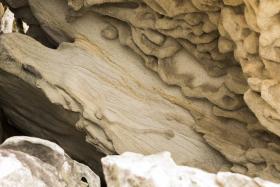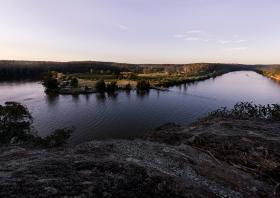When I pictured walking in the desert, I didn’t think about trees. Only red sand, rocky ridgelines and open space. Like many people, during 2020 I resolved to finally go to ‘the Centre’. For me, it was more about the bushfires than COVID. Eighty per cent of the region where I live, on the South Coast of New South Wales, burned during the summer of 2019–2020. Although my own settlement was saved by a last-minute wind change, it’s no longer possible to go anywhere without seeing black trunks and tortured regrowth, without being reminded of those months: smoke, evacuations, apocalyptic skies, the grim rain of black leaves. So many forests I’ve known all my life are forever changed. Other forests around the country, which I’d always meant to visit, also went up in smoke. I felt a new urgency to see as much as I could before it disappears. It’s probably not irrelevant that I had turned 50 just as COVID hit, as the country, the world, was shut down. Life had become a fragile, finite thing. I needed to walk.
Traversing the landscape alone, at pace, particularly among trees, is when I feel most myself. It’s how I process thoughts, feelings, grief. That’s what was happening, of course, although it took a long time to admit it. Grief for the billions of trees, birds and animals that burned. For myself, too: how much I’d lost, which, in retrospect, amounts to a very long childhood; thinking wonder was enough. Suddenly I could see the consequences of 250 years of colonisation: the inevitability of the apocalypse we’re now living in. It was all I could see. I was finding it harder and harder to relate to people who hadn’t experienced the fires, who couldn’t see. People who might say, ‘It’ll all grow back.’ Or, ‘But you’re okay now, right?’
I booked to walk the Larapinta Trail, a 16-day walk along the spine of Tjoritja, or the West MacDonnell Ranges, in the Northern Territory. It wasn’t an original idea; even nine months ahead, it was hard finding a spot. I’d be walking as part of a small group but, somehow, I still imagined being alone. As far as possible from the black leaves still washing up on the beaches, and the sense of alarm that was still waking me in the early hours, every morning.
I’m lucky to get my flights in between waves of COVID, for the trip to go ahead. Our guides, Michael and Lisa, collect me and another walker, Steve, from outside our hotel early the first morning. Bridget and Wendy are already in the back of the 4WD we will come to call ‘the Troopy’, and we pick up Darryl, Alex and two others. I’m one of the youngest but far from the fittest. We’re all wired with excitement, anticipation, and a little trepidation. Together we will walk 223 kilometres, from Mparntwe (Alice Springs) to Rutjupma (Mount Sonder). This is Arrernte Country, and the trail weaves through ancient songlines.
After so long without a horizon it’s a lot to take in, a whole new palette. The sky so very blue, the red quartzite sharp and hard underfoot. The first few days are hot. My mind is fully occupied with walking — and the blisters forming on my feet. But the views are vast and dramatic. We trace the ridgelines during the day and descend to the valley floor to camp.
I’ve been lucky with the season, too. After a big wet, budgies chatter and wheel in vast flocks, green-yellow murmurations, finches — zebra and painted — flit from tree to tree, ring-neck parrots fly by in pairs. The ground is carpeted with fluffy mulla mulla (Ptilotus exaltatus) in various shades of mauve.
There are so many more trees than I expected. River red gums (Eucalyptus camaldulensis) sprawling along the riverbeds and around waterholes. Ghost gums (Corymbia aparrerinja) clinging to red rock high above us in gorges, their roots travelling 70 metres down to find water. When we cross the Alice Valley, between the Chewings and Heavitree ranges, we see just how big they can grow. There are yellow-flowering witchetty bushes (Acacia kempeana), a multi-trunked acacia whose roots are a good source of witchetty grubs. And corkwoods, long-leafed (Hakea lorea) and fork-leafed (Hakea divaricata), with their deeply fissured dark bark and dense yellow flowers.
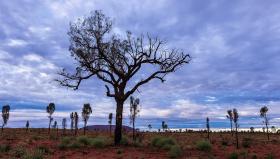
When we walk downhill through a dense woodland of hill mulga undersown with purple mulla mulla, my body softens. There are forests here. Hill mulga, or irrkwarteke, is a species of acacia (Acacia macdonnelliensis) native to central Australia. Steve and I stop to take pictures, in the side-light, lagging far behind Michael and the rest of the group.Even the spinifex looks lush (as long as you don’t touch it), its low humps just the right shade of green against the red. The gorges, waterholes and gaps are true oases, gardens lined with MacDonnell Ranges cycads (Macrozamia macdonnellii), brake fern and the sprawling native figs (Ficus brachypoda), teeming with birds.
But it’s the fire-adapted species I’m most drawn to. The true mulga (Acacia aneura), with their dark bark and strappy green phyllodes, growing on the mountain flanks and in the gullies. Unlike most acacias, which are relatively short-lived, the mature mulga we walk through are more than a century old. Mulga grow slowly, only a metre every 10 years. During drought they can slow themselves down further or even put themselves on pause. They can shapeshift, too, bringing their leaves and branches together in a point, to channel every possible drop of moisture down to their deep taproot.
And the mallees — low-growing, spreading eucalypts with multiple stems springing from an underground lignotuber — which can survive in extremely shallow soils with little moisture. They seem to soften the exposed hillsides and ridges, blurring the red rock with blue-green. I eventually learn to distinguish the round-leaved mallee (Eucalyptus minniritchi) from the Finke River mallee (Eucalyptus sessilis) with its claret, beaked gumnuts. There’s a mallee bloodwood, too (Corymbia eremaea), which, like the larger desert bloodwood, forms bloodwood apples.
There’s another desert tree I keep thinking about. Ahead of the walk, I flew into Uluru. Circumnavigating that monolith and seeing the Mutitjulu waterhole was so much better than I expected. Kata Tjuta, even more so. The Valley of the Winds was such an otherworldly experience, it’s one of my all-time favourite walks. But it was the desert oaks I fell for, standing in that deep red sand, like ancient desert beings.
The desert oak, or kurkara, is a type of she-oak (Allocasuarina decaisneana). It’s the only casuarina in central Australia. Like us, kurkara have juvenile and adult forms. The spindly young trees are not much more than tufts of grey along skinny dark trunks, a bit like a feather duster. What I’d taken for saplings are my age. They spend the first 50 years of their life sending down a deep taproot to access water. Only then do they grow up, transforming into majestic, branching shade trees. Like the mulga, kurkara are slow-growing. Some of those I walked among were 1000 years old. No wonder they have such presence.
Their thick corky bark protects them from flame and heat, while epicormic buds beneath their bark allow them to send out new growth after fire. Their cylindrical woody seedpods, the largest of all casuarinas, produce a prolific number of seeds, which germinate in the ash left behind.
That first night, falling asleep under the stars, the breeze whispering through their needles was like the ocean, a voice or an energy from the heart of this country. Their shushing soothed me, allowing a transformation to begin.
Nothing could have prepared me for the trail. The feeling of walking through the landscape, day after day, the gradual adjustment of my eyes, my body. I had to experience it for myself. When we reach Counts Point, one of the highest and most dramatic vantage points, I struggle with the scale; the ridgelines stretching on and on, the vast valleys and plains. To the west, still more than a week away, we can see our destination: Rutjupma, a pregnant woman reclining, sacred to the West Arrernte.
I find a shaded spot on the edge, to travel back in time. The pressure it must have taken, to buckle plates of rock into these parallel ridges running east to west. Tjoritja is one of the oldest mountain ranges in the world. 310 million years ago it was as high as the Himalayas – 9000 metres – but time, the forces of nature, have worn them down to 1140 metres.
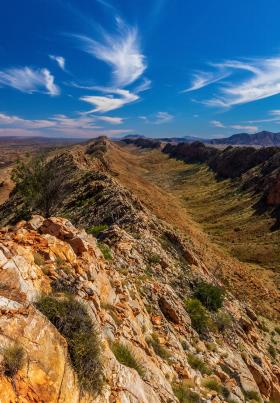
It’s a passage from Kim Mahood’s 2016 book Position Doubtful that helps me find my feet: ‘It’s old, flat eroded country, the isolated outcroppings of granite and quartz and sandstone, like the backbones of buried creatures.’ Mahood is describing different country, the Tanami, in the far north-west, but here, too, it is only the spines left behind. As a visual artist, Mahood has a gift for expressing colour and perspective, which I appreciate even more now that I’m here. Position Doubtful and her earlier Craft for a Dry Lake (2000) are a kind of remapping of our relationship with the continent’s interior and our First Peoples, deconstructing our mythologising of the desert.
The great inland sea is one of those myths, driving white explorers for centuries and becoming part of our collective consciousness. It isn’t until I see the ripplerock — slabs of quartzite with raised, parallel lines — that I understand that it was real. This rock was formed in moving water, the tidal zone of a sea, 800 million years ago.
Darryl, the oldest in our group, speaks from his neighbouring rock. ‘We’re so small.’
I nod. We are just specks, alive only for a moment. It comforts me, somehow, to realise our unimportance. To understand that life, this planet, will go on, despite us. Without us. All I need to do, for now, is to be present, to witness this beauty with this group of people.
It takes time, in any new landscape, to see. Just before we begin our descent from Counts Point, it’s with surprise that I recognise a native pine (Callitris glaucophylla), although I must have walked past many more. The macro photograph I take of its open woody seed cones will turn out to be one of my best, trumping the desert rose and mountain hakea — because I already know it. A related species, white cypress pine (Callitris columellaris), grows on the Finke River with Rwetyepme (Mount Sonder) in the distance. Photo by Inga Simpsonwild part of my family property, in central west New South Wales, that we call ‘up the back’. All through the Weddin Mountains National Park, too, where I first went bushwalking. They’re tough trees, growing alongside ironbarks, my heartwood. Typical of the way settlers named what they saw, they’re not a pine tree at all but a conifer. In Wiradjuri, they are Garraa.
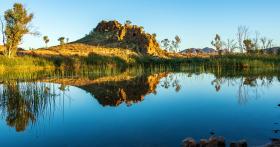
I’m smiling when I walk on. Perhaps it’s the connection with my childhood, a sense of things coming together that has me thinking maybe I could come to know this country. The trees anyway.
These landscapes have burned, too. From lighting strikes, mainly. I see the scars: scorched earth, blackened mulga, the smaller ones petrified in their contracted form, like an upside-down black turnip. The straw-coloured buffel grass, introduced by cameleers, is spreading right through the ranges. The grass makes for hotter fires, killing established trees rather than regenerating the landscape. The native pines and hill mulga are vulnerable, lacking a fire-survival mechanism. They’re becoming scarce along the exposed ridges now.
I didn’t see this country before these fires; it doesn’t haunt me. In my swag beneath the milky way, nothing between me and the landscape, I sleep better than I have for months. Physical exhaustion helps. If I do wake, I just watch the stars arcing across the sky and count those falling to earth. I’m open, but no longer anxious.
One night, there’s a strange shifting wind in camp and I have vivid dreams, waking in tears. I tell Lisa, while she’s making our breakfast, and she says she had a similar experience.
‘Spirits, maybe.’
I knew the landscape would be spectacular. But in the end, it’s the people that make it. The experience binds us as we walk. There are no couples, so we lean on each other. It’s a pilgrimage. Several of us have blisters requiring treatment every morning, there are injuries, and when Alex makes the call to quit, the rest of us pull in tighter.
On our longest walking day, 30 kilometres, I’ve chosen to carry my camera gear rather than extra water. With 10 k to go in the afternoon sun, I’m cooked. Bridget, always moving up and down the line, talking with everyone, sees it in my face. ‘Are you out of water?’ When I nod, she sings out to Steve, who shares some of his.
We get high-fives and hugs from Lisa when we make it back into camp. I hadn’t told anyone, but it’s the furthest I’ve ever walked in a day.
We spend our final nights camped by the Finke, one of the oldest rivers in the world. It’s thick with reeds and birdlife: reed warblers, egrets, herons, cormorants and dotterels, black-shouldered kites circle overhead. When we swim in those cold waters, with Rutjupma looking on, it’s a kind of baptism, healing sore feet and aching joints. Hearts, too. We’re all here for a reason.
On the trail, by the fire at night, out it flows. Again, it’s Position Doubtful that comes to mind, Mahood’s precise expression of the way the body can feel ‘an almost cellular affinity’ to a place constructed in a completely different cultural imagination. On the long drive back to Mparntwe, I see more of my desert oaks. Miles and miles of them, before we shift into different country. We fall quiet, in the Troopy, contemplating the distance we’ve covered. It’s over. But we’re planning another walk together, in the Pilbara, hopefully with our same guides, who we’ve grown fond of. I’ve found the Centre to be a place of such abundance; I’ll never call it the desert again.
Inga Simpson’s account of her life with trees, Understory, was published in 2017.
Her cricket novel, Willowman, will be published by Hachette in October
This story appears in Openbook spring 2022.



